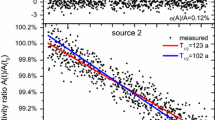Abstract
A recent report on 209Po claimed to have made a determination of the 125-a half-life from measurements made over 0.8 % of one half-life. A careful reanalysis of the original data with a more complete and rigorous consideration of the underlying uncertainties demonstrates that this claim cannot withstand critical scrutiny. More importantly, this critique examines the larger issue as to what constitutes a valid half-life determination, and highlights that a careful and realistic analysis beyond the mere fitting of decay data to an exponential function is required for the measurement and reporting of half-life values.


Similar content being viewed by others
Notes
The ratio of two values Q = x 2/x 1 = exp [(−ln 2) L/T], separated in time by duration L with relative uncertainty ΔQ/Q, propagates to ΔT/T = 1/(λ L) (ΔQ/Q) for the relative uncertainty in the half-life T, with λ = ln 2/T.
The variables in the numerator and denominator for the “activity ratio” as given in Fig. 2 of PSB appear to be inverted on the axis label. It is believed that it should have appeared as A(t)/A(t 0) in order for the ratio to decrease as a function of time with the ratio equal to 100 % at t = t 0.
Certain commercial equipment, instruments, or materials are identified in this paper to foster understanding. Such identification does not imply recommendation by the National Institute of Standards and Technology, nor does it imply that the materials or equipment identified are necessarily the best available for the purpose.
Warping is symmetric in λ = (ln 2)/T about the fitted T, but asymmetric in T, which is exacerbated for short decay periods.
References
Fry C, Thoennessen M (2013) Discovery of the thallium, lead, bismuth, and polonium isotopes. At Data Nucl Data Tables 99:365–389
Kelly EL, Segre E (1949) Some excitation functions on bismuth. Phys Rev 75:999–1005
Andre CG, Huizenga JR, Mech JF, Ramles WJ, Rauh EG, Rocklin SR (1956) Proton cross sections of Bi209. Phys Rev 101:645–651
Martin MJ (1991) Nuclear data sheets for A = 209. Nucl Data Sheets 63:723
NIST, National Institute of Standards and Technology (1995) Certificate, standard reference material 4326, Polonium-209 radioactivity standard. NIST, Gaithersburg, Maryland
Collé R, Zhichao L, Schima FJ, Hodge PA, Thomas JWL, Hutchinson JMR, Coursey BM (1995) Preparation and calibration of carrier-free 209Po solution standards. J Res Natl Inst Stand Tech 100:1–36
Collé R, Laureano-Perez L, Outola I (2007) A note on the half-life of 209Po. Appl Radiat Isot 65:728–730
Collé R (2009) Radionuclidic standardization by primary methods: an overview. J Radioanal Nucl Chem 280:265–273
NIST, National Institute of Standards and Technology (2006) Certificate, Standard Reference Material 4337, Lead-210 Radioactivity Standard. NIST, Gaithersburg, Maryland
Laureano-Perez L, Collé R, Fitzgerald R, Outola I, Pibida L (2007) A liquid-scintillation-based primary standardization of 210Pb. Appl Radiat Isot 65:1368–1380
Collé R, Laureano-Perez L (2009) On the Standardization of 209Po and 210Pb. Advances in liquid scintillation spectrometry LS2008. Radiocarbon, University Arizona, pp 77–85
Anon (2009) In: 2nd INCC proceedings. J Radioanal Nucl Chem 280(2). doi: 10.1007/s10967-009-0500-1
Anon (2011) International topical meeting on polonium and radioactive lead isotopes. J Environ Radioact 102(5):413–534
Christé V, Bé MM (2011) 209Po—Comments on evaluation of decay data, Recommended Data, Laboratoire National Henri Bequerel. http://www.nucleide.org/DDEP_WG/Nuclides/Po-209_com.pdf. Accessed 7 May 2015
Collé R, Fitzgerald RP, Laureano-Perez L (2014) A new determination of the 209Po half-life. J Phys G 41:105103. doi:10.1088/0954-3899/41/10/105103
Collé R, Fitzgerald RP, Laureano-Perez L (2015) Development of an ultra-pure, carrier-free 209Po solution standard, J Res Natl Inst Stds Tech. in press
NIST, National Institute of Standards and Technology (2015) Certificate, standard reference material 4326a, Polonium-209 radioactivity standard. NIST, Gaithersburg, Maryland, pp 282–292
Pommé S, Stroh H, Benedik L (2015) Confirmation of 20 % error in the 209Po half-life. Appl Radiat Isot 97:84–86
Pommé S (2007) Problems with the uncertainty budget of half-life measurements. In: Semkow TM, Jerome SM et al (eds) Applied modelling and computations in nuclear science, vol 945. American Chemical Society, Washington, DC
Pommé S, Camps J, Van Ammel R, Paepen J (2008) Protocol for uncertainty assessment of half-lives. J Radioanal Nucl Chem 276:335–339
Broda R, Cassette P, Kossert K (2007) Radionuclide metrology using liquid scintillation counting. Metrologia 44:S36–S52
Pommé S (2007) Methods for primary standardization of activity. Metrologia 44:S17–S26
Acknowledgments
We are indebted to Dr. Ryan Fitzgerald, research physicist at NIST, for his helpful insights on the general nature of the problem and critical commentary on this text. One of us (RC) extends a silent tribute to those few trying to keep the peer-review process legitimate.
Author information
Authors and Affiliations
Corresponding author
Rights and permissions
About this article
Cite this article
Collé, R., Collé, A.M. On the 209Po half-life error and its confirmation: a critique. J Radioanal Nucl Chem 308, 271–278 (2016). https://doi.org/10.1007/s10967-015-4307-y
Received:
Published:
Issue Date:
DOI: https://doi.org/10.1007/s10967-015-4307-y




